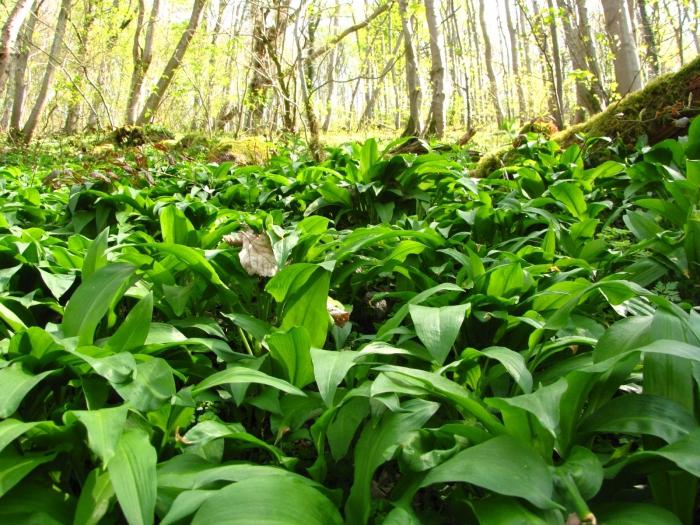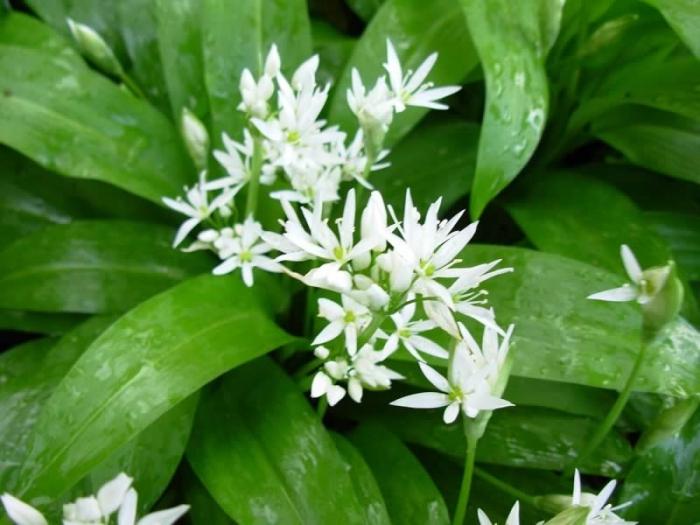Otherwise, this plant is also called "bear garlic." Useful properties of wild garlic - not only in pronounced aroma and attractive aesthetics. This herb also has antibacterial features, cleanses the body and stimulates the digestive system. Bear garlic is a perennial plant that reaches from 20 to 50 centimeters in height. Beneficial features

wild garlic is associated with a translucent membrane, which covers the bare stems and inflorescences in the upper part. Small white flowers are attached to the stem. They are self-pollinating, and flowering time occurs in late April or early May.
Bear garlic forms a capsule, which when opened has several seeds. The beneficial properties of wild garlic are often associated with a specific garlic smell of stems and herbs. Culture is growing both in forest glades and along river banks. A large role is played by moist soil - therefore, in the marshlands of Siberia, the plant thrives. He does not need a large amount of sunlight, so it is often found in shaded deciduous forests. Wild garlic, the benefits of which have already been proven, has been a Red Book plant since 2004. It means,

that you can’t collect wild culture, but you can grow it.
The beneficial properties of wild garlic are reduced during the period of drought. Liqueurs, wines and dishes prepared immediately after the collection of fresh leaves and onions are highly valued primarily as an effective antibacterial product, as well as as a means of stimulating the formation of mucus in the bronchi. Ramson, whose photo can be seen below, is rich in vitamin C and mineral salts.
It lowers blood pressure, prevents atherosclerosis and improves heart function. The plant also stimulates the digestive system to secrete juice and bile. This helps to cleanse the body of the accumulation of harmful substances and encourages the intestines to effectively remove toxins. Bear garlic is also believed to prevent certain types of malignant tumors. The beneficial properties of wild garlic are especially transmitted in tincture, which is made from fresh leaves. Finely chopped stems and herbs

fill a transparent bottle, then fill it to the top with 40% vodka. Canned dishes are kept in a warm place for two weeks, shaking daily. Tincture is used 3-4 times a day, 10-15 drops in a small amount of water.
The beneficial properties of wild garlic are also appreciated in Europe, where it is the richest source of sulfur. It contains vitamins A, C, E and selenium. These substances are antioxidants that can cope with the action of free radicals. Adenosine, which is also found in the plant, has a positive effect on blood circulation throughout the body, especially in the heart and head - this helps with migraines and tinnitus. In Germany, wild garlic is used as a means to lower cholesterol and blood pressure in the treatment of thrombosis, atherosclerosis. This plant is also used to reduce the content of toxins, to regenerate the intestinal flora (which is responsible for the state of our immune system) after antibiotic treatment. Wild garlic has an extremely useful antifungal effect (in the fight against a fungus of the genus Candida Albicans), restores the balance of the gastrointestinal tract. Another advantage is that this plant, used in dried form or in the form of tincture, is devoid of a peculiar smell. Bear garlic can successfully replace green onions or parsley in the decoration of the dish and as a seasoning. In addition, freshly chopped leaves can serve as an excellent side dish for meat dishes.